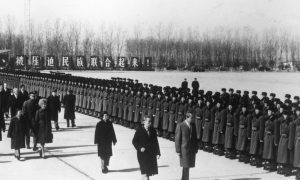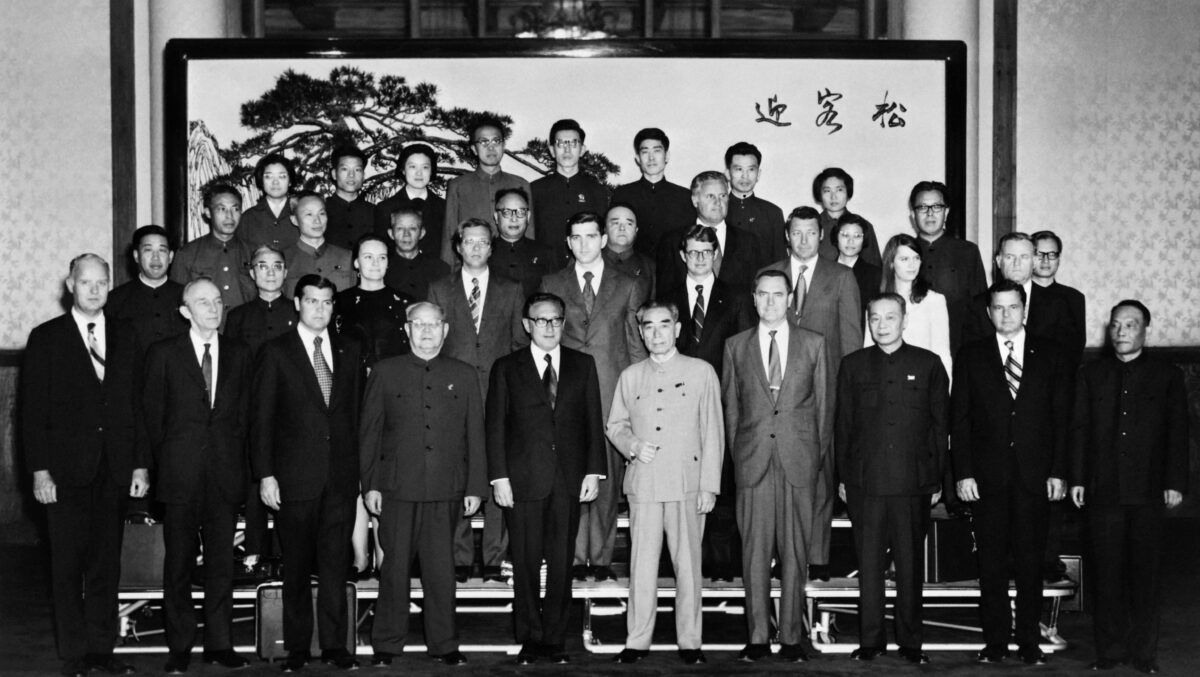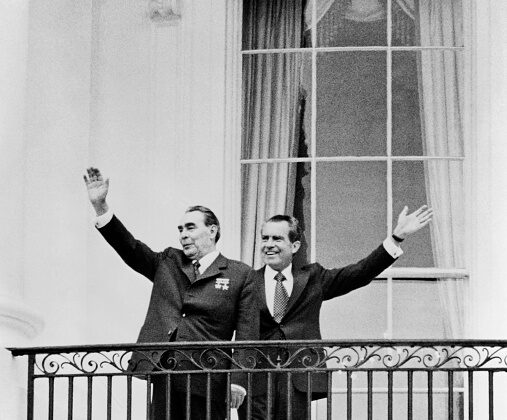How the Overthrow of Richard Nixon Led to the Present US-China Confrontation
Commentary The United States has, since the removal of President Richard Nixon in 1974, been moving along a strategic trajectory largely determined by its adversaries. Strategic success is associated with achieving identified goals and moving upon a trajectory determined by sovereign will rather than by an external force, especially the force of an adversary. So how, a half-century ago, was the situation transformed for the United States—and, along with it, the West—and in a manner that has lain undetected since that time? Few observers, particularly 50 years later, are aware that the paths of the great powers have been anything other than a natural linear extrapolation of their paths at that time. The pivotal change that led to the current global balance of power was achieved without a great interstate kinetic war. This was a change worthy of Sun-tzu’s maxim: “To fight and conquer in all your battles is not supreme excellence; supreme excellence consists in breaking the enemy’s resistance without fighting.” So many of the players who were known to me in this Great Game are now gone, but I recall enough from them and from my own work to piece together the framework of this transformation. Understanding this trajectory gives the opportunity for change. As the American poet Robert Frost (1874-1963) noted: “Two roads diverged in a wood, and I—I took the one less traveled by,And that has made all the difference.” To understand how the United States took “the one less traveled by” and then became sidetracked, we need to go back to the late 1960s and early 1970s. The United States—engaged in a proxy war in Vietnam against the arrayed strength of the Union of Soviet Socialist Republics (the USSR) and the People’s Republic of China (PRC), and in the Cold War against a Soviet-led bloc, including China—saw that the intractable global conflict required a major breakthrough if it was to achieve victory and the end of the Cold War, which had already been underway for a quarter-century. Nixon understood this Gordian knot required a new Alexandrian sword to cut through the complexity. Through the good offices of his national security adviser Dr. Henry Kissinger, and particularly White House Chief of Staff Gen. Alexander M. Haig, Jr., he understood the need to break apart the alliance between the PRC and USSR. This was a fundamental principle of Haig’s mentor and one-time colleague of Kissinger, Dr. Stefan Possony, with whom Nixon consulted. U.S. President Richard Nixon’s special adviser, Henry Kissinger (5 CL), and Chinese Premier Zhou Enlai (6 CL) pose with their delegations for a group photo in Beijing on Oct. 22, 1971. Kissinger traveled to China to meet with Zhou to set the stage for Nixon’s historic visit in 1972. (AFP via Getty Images) I had begun working with Possony at the beginning of 1972, and he put me in touch with Haig in the White House. It should be stressed that, at this time, Kissinger was—albeit brilliant—far junior to the transcendent intellect and experience of Possony, who had already played a key role in persuading Japanese Emperor Hirohito to force the Japanese war cabinet to surrender, ending the war before the USSR could seize more than a few of Japan’s northern islands (the still-disputed Kuriles). Possony knew from deep experience and research just how fragile the alliance was between the USSR and the PRC and had chronicled the border skirmishes that had arisen between the two, while also noting the reality that when the Moscow-Beijing differences flared, then Moscow could no longer resupply North Vietnam via rail links through China. On those occasions, the USSR would ship the supplies needed by North Vietnam by sea from the Northern Soviet ports through the Atlantic, around the Cape of Good Hope and the Indian Ocean, and eventually through the Southeast Asian waterways to Haiphong in North Vietnam. Possony constantly monitored the Sino-Soviet rift, and Possony and Haig, in particular, knew early on just how susceptible the PRC was to being separated from the USSR. There were many in Washington who, believing in monolithic communism, needed convincing that the Soviets and Chinese communists retained an abiding mutual antipathy. Haig, particularly, worked with the Pakistan and Iranian ambassadors to find a secret access point to the leadership of the Chinese Communist Party (CCP), directly to Mao Zedong. Even before he became president in 1969, Nixon had been convinced that the PRC could be separated from the USSR, but attempts at contact had always been rebuffed. Pakistan and Iran were at that time members of the Central Treaty Organization (CENTO), designed to link with NATO in the containment of the Soviet Union. That link to Mao was eventually found, thanks mainly to work by the Pakistani Ambassador to Washington Sultan Mohammed Khan, and by Iranian Foreign Minister (and later, for the second time, Ambassador to Washington) Ardeshir Zahedi, with strong support from Pakistan

Commentary
The United States has, since the removal of President Richard Nixon in 1974, been moving along a strategic trajectory largely determined by its adversaries.
Strategic success is associated with achieving identified goals and moving upon a trajectory determined by sovereign will rather than by an external force, especially the force of an adversary. So how, a half-century ago, was the situation transformed for the United States—and, along with it, the West—and in a manner that has lain undetected since that time?
Few observers, particularly 50 years later, are aware that the paths of the great powers have been anything other than a natural linear extrapolation of their paths at that time. The pivotal change that led to the current global balance of power was achieved without a great interstate kinetic war.
This was a change worthy of Sun-tzu’s maxim: “To fight and conquer in all your battles is not supreme excellence; supreme excellence consists in breaking the enemy’s resistance without fighting.”
So many of the players who were known to me in this Great Game are now gone, but I recall enough from them and from my own work to piece together the framework of this transformation.
Understanding this trajectory gives the opportunity for change.
As the American poet Robert Frost (1874-1963) noted:
“Two roads diverged in a wood, and I—
I took the one less traveled by,
And that has made all the difference.”
To understand how the United States took “the one less traveled by” and then became sidetracked, we need to go back to the late 1960s and early 1970s. The United States—engaged in a proxy war in Vietnam against the arrayed strength of the Union of Soviet Socialist Republics (the USSR) and the People’s Republic of China (PRC), and in the Cold War against a Soviet-led bloc, including China—saw that the intractable global conflict required a major breakthrough if it was to achieve victory and the end of the Cold War, which had already been underway for a quarter-century.
Nixon understood this Gordian knot required a new Alexandrian sword to cut through the complexity. Through the good offices of his national security adviser Dr. Henry Kissinger, and particularly White House Chief of Staff Gen. Alexander M. Haig, Jr., he understood the need to break apart the alliance between the PRC and USSR. This was a fundamental principle of Haig’s mentor and one-time colleague of Kissinger, Dr. Stefan Possony, with whom Nixon consulted.

I had begun working with Possony at the beginning of 1972, and he put me in touch with Haig in the White House. It should be stressed that, at this time, Kissinger was—albeit brilliant—far junior to the transcendent intellect and experience of Possony, who had already played a key role in persuading Japanese Emperor Hirohito to force the Japanese war cabinet to surrender, ending the war before the USSR could seize more than a few of Japan’s northern islands (the still-disputed Kuriles).
Possony knew from deep experience and research just how fragile the alliance was between the USSR and the PRC and had chronicled the border skirmishes that had arisen between the two, while also noting the reality that when the Moscow-Beijing differences flared, then Moscow could no longer resupply North Vietnam via rail links through China. On those occasions, the USSR would ship the supplies needed by North Vietnam by sea from the Northern Soviet ports through the Atlantic, around the Cape of Good Hope and the Indian Ocean, and eventually through the Southeast Asian waterways to Haiphong in North Vietnam.
Possony constantly monitored the Sino-Soviet rift, and Possony and Haig, in particular, knew early on just how susceptible the PRC was to being separated from the USSR. There were many in Washington who, believing in monolithic communism, needed convincing that the Soviets and Chinese communists retained an abiding mutual antipathy.
Haig, particularly, worked with the Pakistan and Iranian ambassadors to find a secret access point to the leadership of the Chinese Communist Party (CCP), directly to Mao Zedong. Even before he became president in 1969, Nixon had been convinced that the PRC could be separated from the USSR, but attempts at contact had always been rebuffed.
Pakistan and Iran were at that time members of the Central Treaty Organization (CENTO), designed to link with NATO in the containment of the Soviet Union.
That link to Mao was eventually found, thanks mainly to work by the Pakistani Ambassador to Washington Sultan Mohammed Khan, and by Iranian Foreign Minister (and later, for the second time, Ambassador to Washington) Ardeshir Zahedi, with strong support from Pakistani Prime Minister Zulfiqar Ali Bhutto, and the Shah of Iran. Mao became intrigued, and Kissinger was eventually able to secretly visit Beijing in July 1971 and began the process of “normalizing” U.S.-China relations, a delicate endeavor. Nixon then visited Beijing in February 1972, and it was expected—particularly by Beijing, on the basis of promises by Kissinger—that key “normalization” issues would be resolved in Nixon’s second presidential term.
Was it to be expected that the Soviet leadership under General Secretary of the Communist Party of the Soviet Union (CPSU) Leonid Brezhnev would just accept this split in the Soviet-led communist alliance against the West?
It was not.
The Soviets had one chance to blunt or delay the impact of the Nixon initiative: to remove Nixon from office before he could begin a second term, because he did win a landslide reelection to the presidency in the November 1972 polls, retaking office in January 1973.

But to be clear, Nixon had not intended to make China a U.S. strategic ally. He merely wished to offer enough to pry Beijing from the arms of Moscow. Neither was Mao under any illusion; the United States remained Beijing’s ultimate strategic adversary. However, the PRC-Soviet relationship was intolerable to the CCP, and Moscow was seen as an immediate threat to Mao.
Nixon’s visit to China was an outstanding initial success, opening the PRC up, ultimately, to the world and isolating the USSR. It was, arguably, the beginning of the end for the Soviet Union. However, it could be argued that the Soviet Union was in an inevitable downward economic spiral, which would later be accelerated by the United States’ economic ability to overwhelmingly challenge the USSR in space-based anti-ballistic missile capability.
The United States, then, was able to ultimately bankrupt the Soviets. That, however, was a decade later during the Ronald Reagan administration.
But Nixon’s distrust of the Chinese communists was no less than his distrust of the Soviet communists. He intended to “divide and conquer” both communist states, not to help the PRC to build up as an independent communist power.
By this time, in the early 1970s, Moscow’s penetration of the U.S. political and intelligence communities was at its height, and the Soviets were determined to use that capability against Nixon—to stop Washington’s splitting strategy.
Unsurprisingly, Moscow would use this unique resource to fight back against the Nixon administration. Nixon was well aware (or believed)—indeed even before his presidency began—that the Soviet intelligence community (the KGB, the GRU, and the International Section of the CPSU) was consistently aware of intimate details of U.S. policy. He believed, too, that the U.S. bureaucracy and political community, particularly the Democratic Party, had been extensively penetrated by Soviet operations.
So Nixon was aware that the Soviets would push back against his initiative with China but did not know who he could trust within the U.S. security apparatus to halt this. Soviet assets, it was felt, were behind the leaks of sensitive material, embarrassing to the U.S. government. And the Nixon White House, unable to turn—rightly as it transpired—to the Federal Bureau of Investigation (FBI) to investigate these issues impartially, created on July 24, 1971, its “plumbers” unit. The plumbers were there to stop the leaks.
Significantly, the plumbers’ existence was disclosed with the Watergate scandal—a disclosure that was possible only because of the complicity of a senior FBI official (later deputy director), William Mark Felt Sr., known by his alias, Deep Throat. It was that Watergate scandal that caused Nixon to resign, and Felt—along with two unwitting Washington Post junior reporters—did what the Soviet leadership wanted. Whether or not Felt was a witting Soviet asset is something that possibly cannot now be known. Still, he did the task that Moscow wanted and was supported by a strenuously pro-Soviet political movement at the time, aligned with such radical mentors as Saul Alinsky.
Why was there no public discussion in the United States at the time about why the plumbers had been formed?
The bottom line, though, is that Moscow succeeded, with key allies in the United States, in removing Nixon from the presidency but not in stopping the CCP from putting its foot in the door of the global power architecture in its own right. Had Nixon remained for his second term, he almost certainly would have succeeded in containing Beijing’s access to the West’s treasures.
Nixon’s immediate successor, Vice-President Gerald Ford, was preoccupied with rebuilding a U.S. polity, shattered as never before—except for the Civil War of the 19th century—by polarizing internal rivalries. Ford’s successor, Jimmy Carter (Democratic Party, 1977–81), was neither interested in Nixon’s strategic rationale nor understood the CCP as a fundamental strategic rival to the United States. Thus, he accelerated Washington’s support of China’s entry into the global framework, without appearing to understand the implications of his actions, either on this or in his abandonment of the Shah of Iran or the Panama Canal.
The denial of Nixon’s second term in office, then, was to have profound consequences.
It stopped the United States from exercising Nixon’s planned containment of both the PRC and USSR and allowed for—facilitated—the rise of the PRC as a major strategic rival of the United States and the West. Mao’s PRC had been, absent the opening provided by the United States, headed for economic implosion at the time of the 1972 Nixon visit. Mao died in 1976, but it is possible that the effects of the Mao-led mass starvations would have destroyed the CCP had the opening to the West not saved his transitional successor, Hua Guofeng, and later CCP administrations.
Would the United States and the West have been strategically more successful if Nixon had never made his 1972 visit? Almost certainly, and particularly if it had been known that Nixon would not have survived, politically, long enough to implement his full containment strategy for the PRC.
Because it was never Nixon’s view that communist China should have survived and prospered.
Views expressed in this article are the opinions of the author and do not necessarily reflect the views of The Epoch Times.












